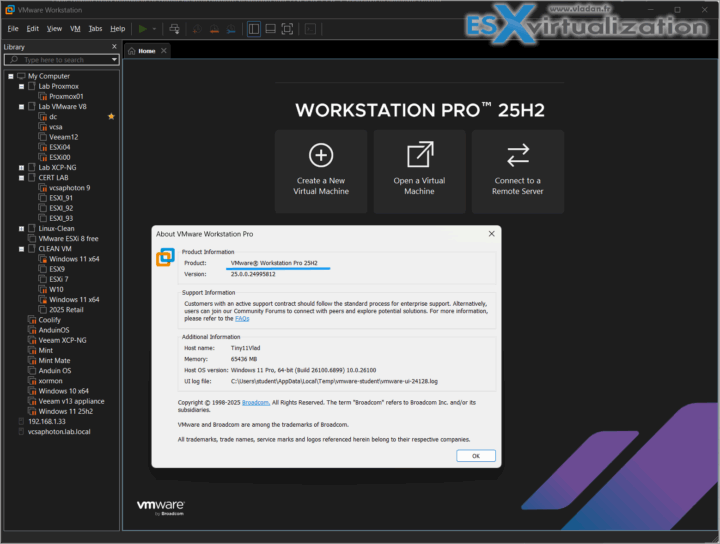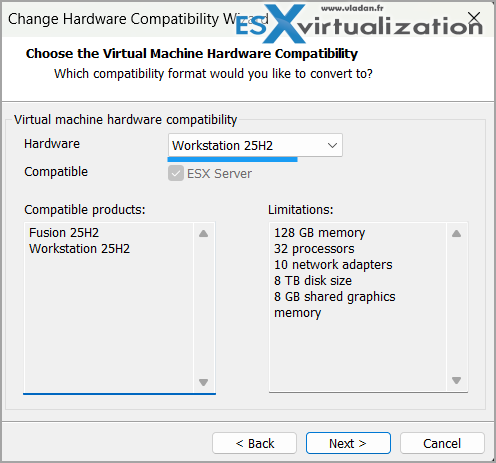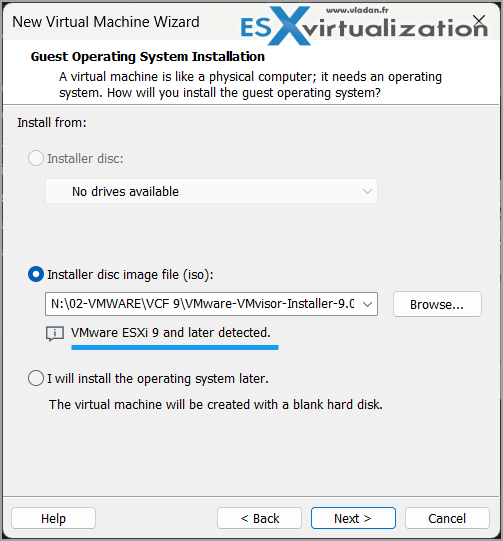If you're anything like me, you've probably spent countless hours tinkering with virtual machines, testing new OS builds, or just spinning up a quick lab environment to mess around with the latest software. VMware Workstation has been my go-to tool for desktop virtualization for years—reliable, powerful, and always evolving. After having a physical lab(s) for years, I swapt to nested virtualization couple of years ago. Saving space, electricity bills and hardware material as well.
Today we're diving into the freshly released VMware Workstation 25H2. Announced just a couple of days ago on October 14, 2025, this version isn't just an incremental update; it's a bold step forward with calendar-based versioning and a slew of features that make it more intuitive and performant than ever.
I had a chance to poke around the release notes and even fire up a test VM, and I have to say, it's got that fresh energy that reminds me why I love this space.In this post, I'll break down what's new, why it matters, and share some hands-on thoughts from my initial setup. Whether you're a developer, IT pro, or just a hobbyist like me, there's something here for you. Let's get into it!
Embracing Calendar Versioning: A Smarter Way to Track Releases
VMware changed the versionning! Is it the good thing? I don't know, but hey, why not.
First things first: goodbye to those cryptic version numbers like 17.6.x or 13.5.2. VMware is shaking things up with a calendar versioning model for both Workstation and Fusion 25H2. The “25H2” stands for 2025, Half 2—simple, right? This isn't just a cosmetic change; it's designed to give you clearer visibility into release cadences and make upgrade planning a breeze.
blogs.vmware.com
As someone who's blogged about VMware for over a decade, I appreciate this shift. It aligns Workstation more closely with enterprise tools like vSphere, where predictability is key. No more guessing if you're on the latest—it's right there in the name. If you've been holding off on upgrades due to version confusion, 25H2 is your cue to jump in.
Key New Features
VMware didn't stop at renaming; they've loaded 25H2 with tools and enhancements that cater to both power users and everyday tinkerers. Let's unpack the highlights.
dictTool: Your New CLI Swiss Army Knife
One of my favorite additions is dictTool, a shiny new command-line utility for inspecting and tweaking VMware configuration files—like .vmx files for VMs or preferences files.
If you've ever needed to automate VM configs or dive deep into settings without firing up the GUI, this is gold. For example, you can query keys, dump entire configs to JSON, or even edit values on the fly. I tested it out on a simple VM setup, running something like dictTool inspect myVM.vmx to pull up all the hardware specs.
Imagine scripting bulk edits for a lab full of VMs—deploying USB passthrough or tweaking memory allocations without manual inputs? For scripters and DevOps folks, it's a must-try.
Pro tip: perhaps pair it with PowerCLI for some serious workflow magic. I'm not a scripting guy, but AI helps you code novadays -:).
USB 3.2 Support and Hardware Version 22: Modern Hardware, Meet Virtualization
Gone are the days of sluggish USB transfers in VMs. 25H2 brings full USB 3.2 support, meaning faster data speeds and better compatibility with the latest peripherals—think high-res webcams for remote work or external SSDs for quick backups.
Hardware Version 22 ( vSphere 9), which unlocks the newest virtual hardware capabilities for your guests. This means better performance across the board—improved graphics, networking, and storage emulation that feels almost native.
If you're running resource-intensive apps like CAD software or ML models in VMs, this version will make a tangible difference.
For Workstation on Windows users, there's also Hyper-V/WHP Detection, which clearly shows if your VM is running in Hyper-V or Windows Hypervisor Platform mode.
The software now detect the ESXi 9 when presented with the installation ISO. Screenshot from the lab below…
Expanded OS Support: Ready for the Future
No VMware release would be complete without broader compatibility, and 25H2 delivers. On the guest side, you can now spin up:
- Red Hat Enterprise Linux 10
- Fedora Linux 42
- openSUSE Leap 16.0 (RC)
- SUSE Linux 16 (Beta)
- Debian 13
- Oracle Linux 10
- VMware ESXi 9.0 (full support in Workstation; Intel-only in Fusion)
- macOS Tahoe (Fusion, Intel systems only)
Hosts get love too: RHEL 10, Fedora 42, and more for Workstation, plus macOS Tahoe across Intel and Apple Silicon for Fusion.
And don't forget expanded CPU support for Intel's Lunar Lake, Arrow Lake, and Meteor Lake chips—perfect if you're on bleeding-edge hardware.
This means your lab can mirror production environments more accurately.
Wrapping Up: Time to Download and Test
VMware Workstation 25H2 isn't revolutionary, but it's evolutionary in the best way: smarter versioning, powerful tools like dictTool, modern hardware support, and those quality-of-life fixes that make daily use joyful. And principally – it's FREE software now. No license required.
If you're still on an older version, grab it now—it's free for personal use, and the Pro edition unlocks even more.What do you think? Have you tried 25H2 yet, or are you sticking with your battle-tested setup? Drop a comment below—I'd love to hear your takes. And if this post helped, give it a share or a thumbs up. Stay tuned for more virtualization deep dives via RSS or my socials. Until next time, keep those VMs running!
Source: VMware Blog
More posts from ESX Virtualization:
- VMware Alternative – OpenNebula: Powering Edge Clouds and GPU-Based AI Workloads with Firecracker and KVM
- Proxmox 9 (BETA 1) is out – What’s new?
- Another VMware Alternative Called Harvester – How does it compare to VMware?
- VMware vSphere 9 Standard and Enterprise Plus – Not Anymore?
- VMware vSphere Foundation (VVF 9) and VMware Cloud Foundation (VCF 9) Has been Released
- Vulnerability in your VMs – VMware Tools Update
- VMware ESXi FREE is FREE again!
- No more FREE licenses of VMware vSphere for vExperts – What’s your options?
- VMware Workstation 17.6.2 Pro does not require any license anymore (FREE)
- Two New VMware Certified Professional Certifications for VMware administrators: VCP-VVF and VCP-VCF
- Patching ESXi Without Reboot – ESXi Live Patch – Yes, since ESXi 8.0 U3
- Update ESXi Host to the latest ESXi 8.0U3b without vCenter
- Upgrade your VMware VCSA to the latest VCSA 8 U3b – latest security patches and bug fixes
- VMware vSphere 8.0 U2 Released – ESXi 8.0 U2 and VCSA 8.0 U2 How to update
- What’s the purpose of those 17 virtual hard disks within VMware vCenter Server Appliance (VCSA) 8.0?
- VMware vSphere 8 Update 2 New Upgrade Process for vCenter Server details
- What’s New in VMware Virtual Hardware v21 and vSphere 8 Update 2?
- vSphere 8.0 Page
- ESXi 7.x to 8.x upgrade scenarios
- VMware vCenter Server 7.03 U3g – Download and patch
- Upgrade VMware ESXi to 7.0 U3 via command line
- VMware vCenter Server 7.0 U3e released – another maintenance release fixing vSphere with Tanzu
- What is The Difference between VMware vSphere, ESXi and vCenter
- How to Configure VMware High Availability (HA) Cluster
Stay tuned through RSS, and social media channels (Twitter, FB, YouTube)




Did they fix nested virtualization in this version? After updating Windows to 24H2, it stopped working. Before W11 24H2, I was able to nest ESXi inside Workstation and run small VMs within it. Is it working again now?
I never had that issue. I’m still on W 11 pro 24H2 as a host, and run nested lab 8.03 with few nested VMs….
I’ve looked into it. Unfortunately, it’s probably due to my CPU — the Intel Ultra 5 125U. It uses a different architecture and integrates differently with Hyper-V in Windows 11.
Just a heads up – Workstation is now free for personal and commercial use.
With VMware Workstation 25H2 the Hosts network speed drops to about 200 till 300 Mbit on Gbit Ethernet Connection as soon a Guest ist running – tried to switch from hyper-v to native VMware Hypervisor but i still have same network speed drop on the Host. Went back to 17.6.4 which is working properly – Probably try again with the next Update of 25H2.
Good to know, thanks for the info. Hopefully they’ll fix it soon.